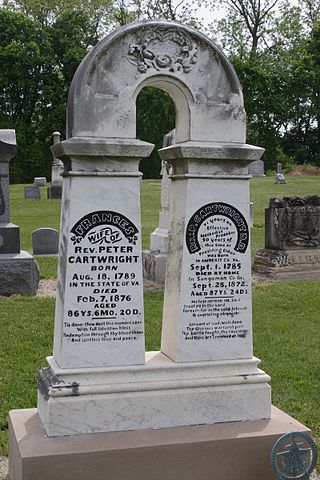Peter Cartwright and the Circuit Riders: A Sustained Revival
To Cartwright, structure expanded revival. The circuit riding method proved uniquely able to bring together a scattered populous under the necessary controls of the church. Ensley observes one key strength of the circuit riding method: “By their circuit system they added enough parishes together to guarantee a livelihood, and their polity assured that every church would have a minister and every minister a church.”[29] The circuit riding elder established a work then appointed exhorters to maintain the work. The elder would visit every six to eight weeks and encourage or correct as needed. Once the work grew larger it might have a located pastor or remain under the leadership of the travelling elder. The church divided into classes much like today’s small groups that provided relational support and encouragement during the week. Cartwright used the methodical system of the Methodist Episcopal Church to sustain a revival and organize the fruits of revival.
The organization of the Methodist Episcopal Church forms part of American culture. Pelikan observes the influence of the system on America: “Because the spirit of the frontier has been shared by colonists and settlers, pioneers and immigrants, the Methodist way of faith and obedience has become embedded in the American experience.”[30] Cartwright, in his sixty-five years as a travelling preacher, witnessed a profound change in frontier culture and Methodist polity. He lived to see his organization begin a descent into an organization with a mission rather than an organization for a mission. Pelikan observes the effects of the changing environment at the end of Cartwright’s life:
If anything, it was the loss of the frontier spirit rather than its retention that gradually alienated Methodism from elements of American society that had been its traditional concern, and caused the Methodist Church to be replaced in their loyalties by forms of Christian witness and obedience that seemed to breathe more of a Wesleyan spirit than the respectable Wesleyans did. Such, at least, has been the judgment of Pentecostal and Holiness churches, which even in their opposition to Methodism represent a Methodist movement, and even in their urban setting belong to the spirit of the American frontier.[31]
Frontier Methodism springs from a missionary spirit in which many movements have taken part. Cartwright’s use of the organization to sustain revival provides an example to those seeking lasting revival today, and it is a warning to the organization to remain organized for mission and not make the organization the mission.

Tombstone of Peter Cartwright in Pleasant Plains, Illinois. Image by Robert Lawton.
Cartwright died on September 25, 1872, shortly after retirement. He remained a presiding elder for fifty years and spent sixty-five years as a circuit rider. No Methodist preacher has come close to his tenure. Cartwright modestly estimates the fruits of his labors at twelve thousand baptisms, ten thousand added to the church, and over 14,600 sermons preached.[32] He sustained the revival fires in which he found salvation for the remainder of his life. He never lost his missional focus and used mediating positions and structure to add strength to his mission. In a feeble voice at his fifty-year jubilee Cartwright describes his life and focus:
And now I retire from the regular work, not because I do not like it, for I say to you one and all, to the young preachers and to the old, that with the losses and crosses, labors and sufferings peculiar to the life of a Methodist traveling preacher, I would take, if it was left to my choice, the same track over again with the same religion to bear me up, rather than be the President of the United States. Glory to God, there is a religion that sustains a man and will bear him on, and up, and through. I have never tried to feel that pasteboard religion that will not allow a man to say amen or shout glory. I have no friendship at all for that kind of Christianity. A Christian still-born into the family of heaven is an anomaly. I love that religion that a man can feel and know for himself, that can support us under trials, that can bear any thing and every thing while God gives us love in our hearts.[33]
PR
Notes
[1] W. S. Hooper, “Introduction,” in Fifty Years as a Presiding Elder, ed. W. S. Hooper (Cincinnati: Jennings and Graham, 1871), 29. https://books.google.com/books?id=-CQFAAAAYAAJ
[2] Philip M. Watters, Peter Cartwright (New York: Eaton and Mains, 1910), 25. https://books.google.com/books?id=C3ZIAAAAYAAJ
[3] Ibid., 31-32.
[4] Benjamin Newman, “The Address of Rev. Dr. Newman,” in Fifty Years as a Presiding Elder, ed. W. S. Hooper (Cincinnati: Jennings and Graham, 1871), 258.
[5] Don C. Seitz, “Peter Cartwright—Evangel of the Backwoods,” in Uncommon Americans: Pencil Portraits of Men and Women Who Have Broken the Rules (Indianapolis: Bobbs-Merrill, 1925), 71.
Category: Church History, Fall 2016


